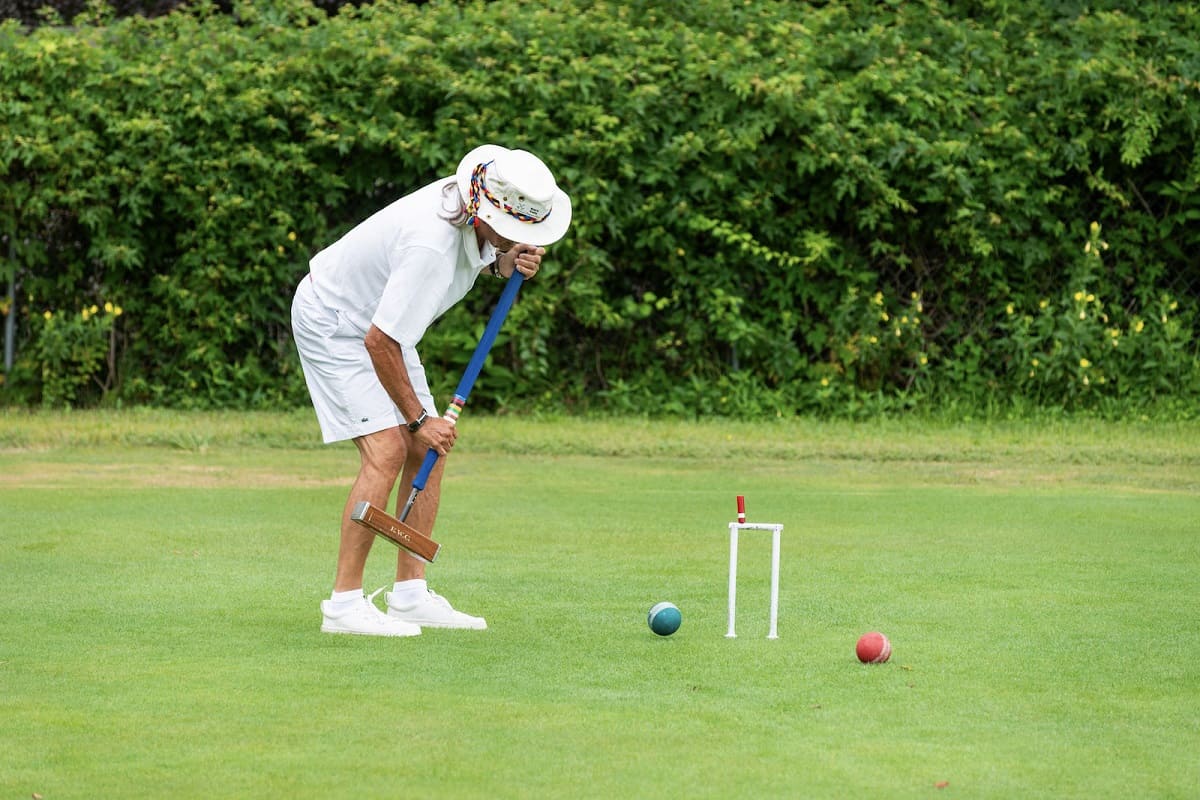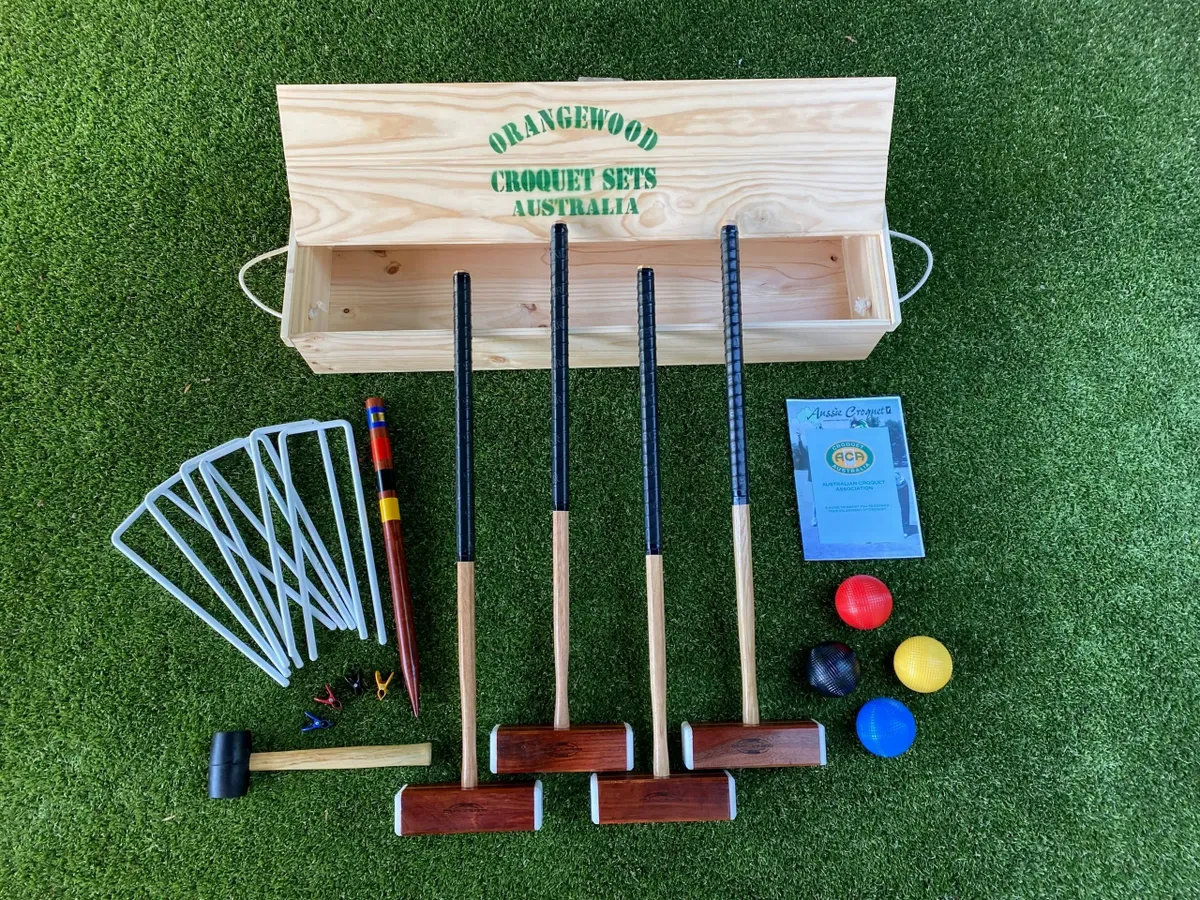Home>Gardening & Outdoor>Outdoor Recreation & Activities>What Are The Rules Of Croquet?


Outdoor Recreation & Activities
What Are The Rules Of Croquet?
Published: February 2, 2024
Discover the rules of croquet and learn how to play this classic outdoor recreation and activity. Find out the essential guidelines for enjoying a game of croquet with friends and family.
(Many of the links in this article redirect to a specific reviewed product. Your purchase of these products through affiliate links helps to generate commission for Storables.com, at no extra cost. Learn more)
Introduction
Croquet is a classic outdoor game that combines elements of strategy, precision, and finesse. Dating back to the 19th century, croquet has evolved from a leisurely pastime to a competitive sport enjoyed by people of all ages. Whether played casually in a backyard setting or in organized tournaments, croquet offers a delightful blend of social interaction and skillful gameplay.
The game is typically played on a grassy court, where players take turns using a mallet to hit colored balls through a series of hoops, also known as wickets. The objective is to navigate the course and successfully strike the balls in a specific sequence, ultimately aiming to be the first to complete the course and earn the highest score.
What sets croquet apart is its accessibility and versatility. It can be enjoyed in various settings, from formal lawns to more relaxed backyard environments, making it a popular choice for gatherings and events. The game's straightforward yet engaging nature makes it suitable for players of different skill levels, from beginners to seasoned enthusiasts.
As a game that encourages friendly competition and camaraderie, croquet fosters an atmosphere of lighthearted enjoyment. It provides an opportunity for players to showcase their strategic thinking, hand-eye coordination, and ability to adapt to changing circumstances on the court. Whether played in a spirited match or as a leisurely pastime, croquet offers a unique blend of mental agility and physical dexterity.
In the following sections, we will delve into the essential aspects of croquet, including the basic equipment required, the setup of the court, fundamental rules of play, scoring mechanics, as well as advanced strategies for those seeking to elevate their game. By gaining a comprehensive understanding of the rules and strategies, players can enhance their enjoyment of this timeless game and further appreciate the intricacies it offers.
Key Takeaways:
- Croquet is a classic outdoor game that combines strategy, precision, and social interaction, making it a delightful pastime for players of all ages in various settings.
- Understanding the basic rules, scoring mechanics, and advanced strategies can enhance the enjoyment of croquet, fostering a sense of skill, camaraderie, and competitive spirit.
Read more: What Is Croquet? (The Game)
Basic Equipment
To embark on a game of croquet, it's essential to have the right equipment at hand. The fundamental components include mallets, balls, hoops (wickets), and a peg. Let's delve into the specifics of each item:
-
Mallets: A set of croquet mallets typically consists of six mallets, each uniquely colored to correspond with the matching balls. These mallets are designed with varying lengths and weights to accommodate players of different heights and strengths. The head of the mallet is equipped with a striking face, allowing players to maneuver the balls with precision and control.
-
Balls: Croquet involves the use of six colored balls, often in traditional shades of blue, red, black, yellow, green, and orange. These balls are crafted to withstand outdoor play and are sized to fit through the hoops on the course. The distinct colors not only add a vibrant visual element to the game but also serve to differentiate each player's set of balls.
-
Hoops (Wickets): The croquet course is delineated by a series of hoops, also known as wickets, which are strategically positioned on the playing field. These hoops are designed to be sturdy yet easily movable, allowing for flexibility in course layout. The objective is to guide the balls through the hoops in a specific sequence, adding an element of precision and strategy to the game.
-
Peg: Positioned at the center of the court, the peg serves as the ultimate target for players to conclude the game. Once a player's ball has navigated through all the hoops in the prescribed order, the final challenge is to strike the ball against the peg, signaling the successful completion of the course.
In addition to these primary components, it's advisable to have boundary markers to define the court's limits and a sturdy, level surface for optimal gameplay. While the basic equipment forms the foundation of a croquet match, players may also choose to incorporate accessories such as gloves for added grip and comfort during play.
By ensuring that the necessary equipment is in place and well-maintained, players can fully immerse themselves in the strategic and enjoyable experience that croquet offers. With the right tools at their disposal, participants can focus on honing their skills and embracing the camaraderie that comes with this timeless game.
Setting Up the Court
Setting up the croquet court is a crucial aspect that contributes to the overall enjoyment and fairness of the game. The process involves creating a well-defined playing area that accommodates the strategic layout of hoops and the positioning of the peg. Here's a detailed guide on how to set up the court for a captivating game of croquet:
Court Dimensions
The standard croquet court measures 50 feet by 100 feet, providing ample space for players to maneuver and strategize. The rectangular shape of the court allows for a balanced layout of the hoops and ensures that players have sufficient room to navigate their balls through the course. It's essential to maintain the court's dimensions to uphold the integrity of the game and provide a consistent playing experience.
Hoop Placement
The placement of the hoops, or wickets, is a defining factor in shaping the course's complexity and challenge. The traditional croquet court features a total of six hoops, with three positioned along each of the longer sides of the court. The hoops are evenly spaced and aligned to create a sequential path for the balls to traverse. Careful consideration is given to the distance between the hoops, striking a balance between attainable progression and strategic difficulty.
Read more: When Was Croquet Invented?
Peg Positioning
At the center of the court, the peg serves as the focal point and ultimate target for players to aim for. Positioned equidistant from the shorter ends of the court, the peg stands as the final challenge for players to conquer. Its strategic placement adds a compelling dimension to the game, requiring players to navigate their balls through the hoops before directing their efforts toward striking the peg to conclude the match.
Surface Preparation
A level and well-maintained playing surface are essential for ensuring fair and consistent gameplay. Whether played on grass or a specialized croquet court, the surface should be free of obstructions and irregularities that could impede the movement of the balls. Additionally, clear boundary markers are used to define the court's limits, providing players with a definitive area in which to engage in the strategic interplay of the game.
By meticulously setting up the croquet court according to these guidelines, players can immerse themselves in a captivating and skillful game that showcases the nuanced blend of precision, strategy, and camaraderie that defines the timeless appeal of croquet.
Basic Rules of Play
The basic rules of croquet form the foundation of the game, providing a framework for engaging and strategic gameplay. Understanding and adhering to these rules is essential for players to navigate the course, interact with opponents, and ultimately achieve victory. Here's a comprehensive overview of the fundamental rules that govern the captivating game of croquet:
Turn-Based Play
Croquet is structured around a turn-based system, where players take alternating turns to maneuver their balls through the course. Each player's turn begins with striking their ball with the mallet, aiming to progress through the hoops in the prescribed sequence. The sequential nature of the game adds an element of strategy, as players must anticipate and adapt to the positioning of their opponents' balls.
Read more: What Is A Croquet Field Called?
Hoop Navigation
The primary objective of the game is to guide the balls through the hoops in a specific order. Players must skillfully navigate their balls through the hoops, ensuring that they pass through in the correct direction. Successfully passing through a hoop grants the player an additional stroke, providing an opportunity to strategically position their ball for subsequent maneuvers.
Ball Contact
During their turn, players aim to make contact with their own ball using the mallet. The striking face of the mallet is used to propel the ball, allowing players to exert control over its direction and velocity. Precision and finesse are key as players seek to position their balls strategically while impeding the progress of their opponents' balls.
Roqueting and Croqueting
Two essential techniques in croquet are roqueting and croqueting. Roqueting occurs when a player's ball strikes another player's ball, resulting in the ability to take an additional shot. Croqueting involves striking one's own ball while in contact with an opponent's ball, enabling the player to move both balls and strategically position them for subsequent maneuvers.
Continuation and Completion
Players continue taking turns, navigating their balls through the hoops and strategically positioning themselves for the final challenge: striking the peg. Once a player's ball has passed through all the hoops in the correct sequence, the final objective is to strike the ball against the peg, signaling the successful completion of the course and the attainment of victory.
By adhering to these fundamental rules of play, participants can engage in a captivating and skillful game of croquet, showcasing their strategic acumen and finesse while embracing the camaraderie and competitive spirit that define this timeless outdoor activity.
Read more: What Are The Cornhole Rules?
Scoring
Scoring in croquet is a fundamental aspect that adds structure and competitive intrigue to the game. Understanding the scoring mechanics is essential for players to gauge their progress, strategize their moves, and ultimately strive for victory. The scoring system in croquet is designed to reflect the players' proficiency in navigating the course, as well as their ability to outmaneuver opponents. Here's a comprehensive exploration of the scoring dynamics that underpin the captivating game of croquet:
Hoop Points
Each successful navigation of a hoop yields points for the player, reflecting their precision and strategic prowess. As a player's ball passes through a hoop in the correct sequence, they are awarded a predetermined number of points, typically ranging from one to six, depending on the specific hoop. This incremental scoring system incentivizes players to meticulously guide their balls through the hoops, as each successful passage contributes to their overall score.
Completion Bonus
Upon successfully navigating their ball through all the hoops in the prescribed order and striking the peg, players are awarded a substantial completion bonus. This bonus serves as a testament to the player's comprehensive mastery of the course and their ability to execute the final maneuver with finesse. The completion bonus significantly bolsters the player's total score, underscoring the significance of successfully concluding the game.
Opponent Interaction
The scoring system in croquet also incorporates elements of interaction with opponents' balls. Roqueting and croqueting, which involve striking an opponent's ball and leveraging the resulting advantages, can yield additional points for the initiating player. These points reflect the strategic acumen and tactical foresight demonstrated by the player in utilizing interactions with opponents' balls to their advantage.
Read more: How To Win At Croquet
Penalties
In contrast to the positive scoring mechanisms, penalties are imposed for infractions such as fouls or rule violations. These deductions serve as a deterrent against unsportsmanlike conduct and errors that compromise the integrity of the game. By incorporating penalties into the scoring system, croquet emphasizes the importance of fair play and adherence to the established rules, ensuring a balanced and equitable playing environment.
Total Accumulation
Throughout the game, players accumulate points based on their successful hoop navigation, completion of the course, and strategic interactions with opponents' balls. The total accumulation of points serves as a comprehensive reflection of the player's performance, encompassing their precision, strategic foresight, and ability to capitalize on interactions with opponents. The culmination of these scoring elements determines the victor, highlighting the player who has demonstrated the most adept and strategic gameplay.
By comprehensively understanding the scoring mechanics in croquet, players can appreciate the nuanced interplay of precision, strategy, and interaction that defines the game. The scoring system serves as a compelling measure of players' skill and sportsmanship, enriching the competitive dynamics and fostering an engaging and strategic gameplay experience.
Fouls and Penalties
In the spirited game of croquet, adherence to rules and sportsmanlike conduct is paramount. Understanding the fouls and penalties is essential for maintaining fairness and integrity throughout the gameplay. Here's an in-depth exploration of the fouls and penalties that players should be mindful of during a game of croquet:
Hoop and Ball Contact Violations
Fouls can occur when a player's ball fails to make contact with the designated ball or the appropriate hoop. If a player's ball neglects to pass through the correct hoop in the prescribed order, it constitutes a violation. Similarly, failing to make contact with the designated ball during a turn can result in a foul. These violations emphasize the importance of precision and adherence to the sequential navigation of the course.
Read more: What Are The Rules For A Table Centerpiece?
Boundary Infringements
The boundaries of the croquet court serve as a delineation of the playing area, and players are expected to respect these limits. Crossing or striking a ball beyond the designated boundaries can lead to penalties. By upholding the boundaries, players ensure a fair and consistent playing field, thereby contributing to the overall integrity of the game.
Mallet Contact Infractions
Improper use of the mallet, such as striking the wrong ball or making contact with a ball out of turn, can result in penalties. The mallet serves as a tool for precision and control, and its proper utilization is integral to the strategic dynamics of the game. Infractions related to mallet contact underscore the significance of deliberate and calculated maneuvers during gameplay.
Unsportsmanlike Behavior
Instances of unsportsmanlike conduct, such as intentional interference with opponents' balls or disruptive behavior, can lead to penalties. Maintaining a respectful and sportsmanlike demeanor is fundamental to the ethos of croquet, fostering an environment of friendly competition and mutual respect among players.
Penalty Ramifications
Penalties in croquet typically result in the loss of a turn or the deduction of points from the player's score. These ramifications serve as a deterrent against infractions and unsportsmanlike behavior, reinforcing the importance of upholding the rules and exhibiting decorum throughout the game.
By upholding the rules and respecting the established guidelines, players contribute to a harmonious and equitable gameplay experience. Understanding the potential fouls and penalties not only ensures fair and sportsmanlike conduct but also underscores the strategic and disciplined nature of croquet as a game that values precision, strategy, and camaraderie.
Read more: How To Play Croquet
Advanced Strategies
In the realm of croquet, mastering advanced strategies can elevate a player's game to new heights, offering a deeper understanding of the nuanced tactics and maneuvers that can influence the outcome of a match. As players progress in their croquet journey, they can explore a myriad of advanced strategies aimed at enhancing their precision, outmaneuvering opponents, and strategically positioning their balls for optimal advantage.
Tactical Ball Placement
Strategic ball placement is a cornerstone of advanced croquet gameplay. Players can strategically position their balls in proximity to the next hoop, setting the stage for a seamless transition to the subsequent maneuver. By astutely considering the trajectory and positioning of their opponents' balls, players can anticipate and counteract potential obstacles, thereby gaining a strategic edge in navigating the course.
Interference and Displacement
Leveraging interactions with opponents' balls to disrupt their positioning and impede their progress is a tactical ploy employed in advanced croquet strategies. By strategically roqueting or croqueting opponents' balls, players can alter the landscape of the course, creating advantageous scenarios for their own progression while introducing challenges for their adversaries.
Defensive Maneuvers
Incorporating defensive maneuvers into gameplay can fortify a player's position and thwart opponents' advances. By strategically positioning their balls in a manner that obstructs the path of opponents' balls or creates challenging angles for subsequent shots, players can assert defensive dominance while maintaining a strategic foothold on the course.
Read more: What Are The Rules For Playing Jenga
Multi-Ball Tactics
Advanced players can adeptly navigate the complexities of multi-ball scenarios, where the strategic interplay between multiple balls introduces heightened intricacy and tactical depth. By orchestrating coordinated movements and leveraging interactions between their own balls, players can orchestrate multi-ball tactics to outmaneuver opponents and create strategic advantages that propel them closer to victory.
Adaptive Course Navigation
Adaptability is a hallmark of advanced croquet strategies, as players adeptly respond to evolving course dynamics and capitalize on unforeseen opportunities. By dynamically adjusting their approach based on the positioning of their own and opponents' balls, players can exhibit a keen ability to adapt to changing circumstances, showcasing their strategic agility and resilience in the face of challenges.
Precision Peg Strikes
The culmination of advanced croquet strategies often hinges on the precision and finesse exhibited in striking the peg to conclude the game. Players can meticulously position their balls to optimize their approach to the peg, carefully calculating the trajectory and force required to execute the final maneuver with utmost precision, thereby solidifying their mastery of the course.
By delving into these advanced strategies, players can enrich their croquet experience, honing their strategic acumen and finesse while embracing the dynamic interplay of precision, tactics, and strategic foresight. These advanced strategies not only enhance the competitive dynamics of croquet but also underscore the captivating blend of skill and strategy that defines this timeless outdoor pursuit.
Conclusion
In conclusion, croquet stands as a timeless outdoor activity that seamlessly blends strategic gameplay with social interaction, offering a delightful pastime for players of all ages. From the meticulous setup of the court to the precision and finesse required in navigating the course, croquet embodies a captivating fusion of skill, strategy, and camaraderie.
As players embark on a game of croquet, the essential equipment, including mallets, balls, hoops, and the peg, forms the foundation for an engaging and skillful match. The careful arrangement of the court, with its defined dimensions, strategically positioned hoops, and central peg, sets the stage for a captivating gameplay experience.
Understanding the basic rules of play, from turn-based maneuvers to strategic hoop navigation, provides players with a framework for engaging in skillful and strategic gameplay. The scoring mechanics, coupled with penalties for infractions, underscore the importance of precision, fair play, and adherence to the established rules.
Moreover, the advanced strategies in croquet offer players the opportunity to delve deeper into the tactical intricacies of the game, elevating their gameplay through strategic ball placement, tactical interference, defensive maneuvers, and adaptive course navigation.
Ultimately, croquet transcends its role as a leisurely outdoor activity, evolving into a competitive sport that demands precision, strategic acumen, and adaptability. The game fosters an environment where players can showcase their skills, engage in friendly competition, and forge lasting memories with friends and family.
Whether played in a formal setting or as a casual pastime, croquet embodies the spirit of outdoor recreation, offering a refreshing blend of mental agility and physical dexterity. As players immerse themselves in the strategic interplay of the game, they not only hone their skills but also cultivate a sense of camaraderie and sportsmanship.
In essence, croquet remains a cherished pursuit that transcends generations, inviting players to partake in a timeless tradition that celebrates skill, strategy, and the joy of outdoor play. With its rich history and enduring appeal, croquet continues to captivate enthusiasts and newcomers alike, embodying the essence of leisurely sophistication and strategic engagement in the great outdoors.
Frequently Asked Questions about What Are The Rules Of Croquet?
Was this page helpful?
At Storables.com, we guarantee accurate and reliable information. Our content, validated by Expert Board Contributors, is crafted following stringent Editorial Policies. We're committed to providing you with well-researched, expert-backed insights for all your informational needs.









0 thoughts on “What Are The Rules Of Croquet?”